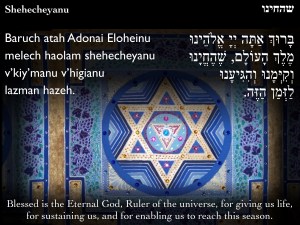How to get 6000+ people on the same page for a service? When we started Rosh Hashanah Under the Stars more than a decade ago, we didn’t even know this was an important question to address.
Laura Black, a decades-long member of the congregation, mentioned her idea to Cantor Judi Rowland while both were working out at the gym. She told Judi that while her adult children had no interest in joining her for our ‘regular’ services, she thought that she could persuade them if we would hold a service outside somewhere, maybe in a park. We were taken with the idea as Cantor Rowland, Rabbi Rex Perlmeter and I thought about the possibilities for engagement and outreach. We began plans to take our ‘Alternative/Family’ service out of the social hall and into Oregon Ridge Park where the Baltimore Symphony Orchestra regularly holds their summer concert series.

As we concocted that first RHUS, we had a couple of principles in mind that still hold 11 years later. We wanted the service to be free, open to the public, accessible and warm. We wanted people to know that even though they would be welcome wearing shorts, eating picnics, not shushing their kids, that this would be a service and not an “event.” For that first year, our clergy team put together a small service booklet and ambitiously printed double the number of attendees we expected. “If 500 people show up,” we thought, “that will be incredible!” When that first Erev Rosh Hashanah arrived, we found that we had over 1500 in our remarkable congregation.
 During the second and third year’s planning meetings, I fretted that many of those booklets had not returned to us. I was concerned about the potential chilul of where those booklets might have ended up and about the environmental waste of resources that would not be re-used and possibly not recycled. I wanted to revise some of the language we had chosen, but didn’t want to get rid of all the books we still had on hand. Some time between the third and fifth year I encountered Visual T’filah at a convention. At first I was wary – prayers projected on a huge screen felt too ‘megachurchy,’ too ‘non-Jewish’ for all the obvious reasons. But I also found the pictures accompanying prayers engaging and the images added intriguing layers of meaning.
During the second and third year’s planning meetings, I fretted that many of those booklets had not returned to us. I was concerned about the potential chilul of where those booklets might have ended up and about the environmental waste of resources that would not be re-used and possibly not recycled. I wanted to revise some of the language we had chosen, but didn’t want to get rid of all the books we still had on hand. Some time between the third and fifth year I encountered Visual T’filah at a convention. At first I was wary – prayers projected on a huge screen felt too ‘megachurchy,’ too ‘non-Jewish’ for all the obvious reasons. But I also found the pictures accompanying prayers engaging and the images added intriguing layers of meaning.

I reached out to Rabbi Dan Medwin, Visual T’filah’s creator, and gathered a small group of smart and creative congregants. We studied the Erev Rosh Hashanah service and decided on imagery. One offered his own photography, another her own artwork. We went through revisions with Dan and finalized a beautiful prayer book that would be displayed on a jumbo screen flanking the band shell transformed into a bima. In 2011 Visual T’filah became the prayer book of RHUS. In the years that followed, we were able to change translations, swap songs and add or remove images without any of the attendant waste. After a year or two, as ipads and smart phones became ubiquitous, we wanted people to have the option of downloading the service in advance. This felt especially important for the attendees toward the back of the ever-growing crowd. Dan devised and revised the download process so that attendees could have it in hand or watch it on the big screen.
Who knows what alchemy has allowed RHUS to grow to over 6000 attendees in the decade+ of its existence? We now have two jumbo screens as well as banks of enormous speakers. There are families whose children have never known an Erev Rosh Hashana without Visual T’filah, lawn chairs, and fantastically vibrant community. BHC members come together with unaffiliated Jews, folks who belong to other Reform, Conservative and even Orthodox congregations in Baltimore, Washington DC, Virginia, and Pennsylvania and a handful of non-Jews who just want to share in the celebration of a New Year with us. It is truly a blessing to have 6000+ people together on the same jumbo page, if only for one service a year.
—
Rabbi Elissa Sachs-Kohen is one of the rabbis at Baltimore Hebrew Congregation where she has served for 14 years.








 invest in their own copy. Many pre-purchased the book and we provided personalized bookplates. We had a number of copies for congregants to borrow and on Rosh HaShanah, all of the books had a card inside. I invited the congregation once again to purchase their own copy. I asked them to fill out the card that evening, give it to a greeter, and then take the book home. The next week, we had the Yom Kippur edition and
invest in their own copy. Many pre-purchased the book and we provided personalized bookplates. We had a number of copies for congregants to borrow and on Rosh HaShanah, all of the books had a card inside. I invited the congregation once again to purchase their own copy. I asked them to fill out the card that evening, give it to a greeter, and then take the book home. The next week, we had the Yom Kippur edition and 


